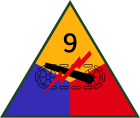9th Armored Division (United States)
|
9th Armored Division |
|
|---|---|
 Badge of the 9th US Armored Division Phantom |
|
| active | 1941 to July 15, 1963 |
| Country |
|
| Armed forces | United States Armed Forces |
| Armed forces | United States Army |
| Branch of service | tank |
| Type | Armored Division |
| structure | structure |
| Strength | Should: 15,000+ |
| Nickname | "Phantom" |
| Colours | Blue, red, gold, black |
| march | Spearhead March |
| Butcher | Second World War |
| Commanders | |
| Important commanders |
John W. Leonard , 1942–1945 |

The 9th Armored Division ( German 9th US Panzer Division , nickname "Phantom Division") was a tank division of the United States Army . She fought on the Western Front in World War II in 1944/45 .
She gained a certain fame within the Army for extraordinary heroism when she repelled the constant and determined attacks of an entire German division from December 16, 1944 (the day the Ardennes offensive began) to December 22. With a power ratio of 5: 1, employees, cooks, mechanics, drivers and others manned a nine-kilometer front line.
history
The division was activated on July 15, 1942 in Fort Riley , Kansas state .
It reached Great Britain in September 1944 (by which time Paris had already capitulated).
Fortitude
The 9th Armored Division was one of several (actually existing) US Army divisions that took part in Operation Fortitude . The Allies successfully deceived the Wehrmacht and made them believe that the actual invasion would take place in the Dunkirk area. The Wehrmacht fell for it and kept troops in the Dunkirk area instead of opposing the troops that landed in Normandy on June 6, 1944 ( Operation Overlord ).
Mission history
The US 9th Panzer Division landed in Normandy at the end of September 1944 and first came into contact with the front on October 23, 1944 while patrolling a quiet sector along the border between Luxembourg and Germany.
When the Wehrmacht began their last major offensive on December 16, 1944, the 9th (which had practically no combat experience) was involved in heavy fighting. The heaviest battles were around St. Vith , Echternach and Bastogne .
She was able to defend Bastogne (see Siege of Bastogne ) until relief troops from the 101st Airborne reached Bastogne.
After a recovery phase in January 1945, the division prepared to cross the Rur . The offensive - Operation Grenade - took place on February 28, 1945; the 9th advanced over the Rur in the direction of Rheinbach ( Operation Lumberjack ) and sent patrols and advance commands to Remagen . To their surprise, they found the Ludendorff Bridge intact; she managed to conquer it.
Later she expanded the bridgehead on the right bank of the Rhine. They advanced along the Lahn upriver to Limburg an der Lahn , where they freed thousands of Allied prisoners of war.
She then marched to Frankfurt am Main and then swung north to help close the Ruhr pocket. In April it advanced east towards Leipzig , circled it and secured a line along the river Mulde . Then she swiveled south towards Czechoslovakia. The war in Europe ended on 8/9. May 1945.
Units of the 9th US Armored Division
- 2nd Tank Battalion
- 14th Tank Battalion
- 19th Tank Battalion
- 27th Armored Infantry Battalion
- 52nd Armored Infantry Battalion
- 60th Armored Infantry Battalion
- HHB, Artillery Division
- 3rd Armored Field Artillery Battalion
- 16th Armored Field Artillery Battalion
- 73rd Armored Field Artillery Battalion
- 89th Cavalry Reconnaissance Squadron, Mechanized
- 509th Counter Intelligence Corps Detachment
- Headquarters Company, 9th Armored Division
- HHC , Combat Command A
- HHC, Combat Command B
- Headquarters, Reserve Command
- Headquarters, 12th Armored Group
- HHC, Trains Division
- 2nd Medical Battalion
- 131st Armored Ordnance Maintenance Battalion
- Military Police Platoon
- 9th Armored Engineer Battalion
- 149th Armored Signal Company
- 656th Tank Destroyer Battalion (affiliated February 22, 1945 to May 9, 1945)
- 811th Tank Destroyer Battalion (affiliated November 14, 1944 through January 8, 1945)
- 482nd AAA Automatic Weapons Battalion (affiliated November 22, 1945 to January 9, 1945; February 22, 1945 to May 9, 1945)
Commanders
| Major General Geoffrey Keyes | June to September 1942 |
| Major General John W. Leonard | October 1942 to October 1945 |
Web links
- The 9th: The Story of the 9th Armored Division (WWII unit history booklet; English)
- 1st Cavalry - 3rd Combat Team ( Memento from July 17, 2007 in the Internet Archive ) (English)
Footnotes
- ↑ 2nd Cavalry Division, WWII Era patch . In: Army to WWII Era . Retrieved November 5, 2011.
